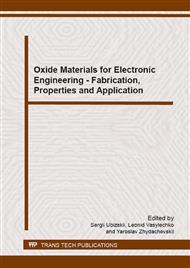[1]
H. Maeda, Y. Tanaka, M. Fukutomi, T. Asano, A New High-Tc Oxide Superconductor without a Rare Earth Element, Jpn. J. Appl. Phys., Part 2, 27 (1988) L209-L210.
DOI: 10.1143/jjap.27.l209
Google Scholar
[2]
P. Villars, K. Cenzual (Eds. ), Pearson's Crystal Data: Crystal Structure Database for Inorganic Compounds, Release 2013/14, ASM International®, Materials Park, Ohio, USA.
Google Scholar
[3]
R. Gladyshevskii, O. Shcherban, R. Flükiger, The influence of Bi/Pb substitution on the crystal structure of the Bi2Sr2CaCu2O8+d superconductor, Visn. Lviv. Univ., Ser. Khim., 39 (2000) 201-204.
Google Scholar
[4]
R. Gladyshevskii, N. Musolino, R. Flükiger, Structural origin of the low superconducting anisotropy of Bi1. 7Pb0. 4Sr2Ca0. 9Cu2O8, Phys. Rev. B, 70 (2004), 1-8.
DOI: 10.1103/physrevb.70.184522
Google Scholar
[5]
R.E. Gladyshevskii, Ph. Galez, Crystal Structures of High-Tc Superconducting Cuprates, in: Ch.P. Poole, Jr. (Ed. ), Handbook of Superconductivity, Academic Press, San Diego, 1999, pp.267-431.
DOI: 10.1016/b978-012561460-3/50009-6
Google Scholar
[6]
A. Jeremie, K. Alami-Yadri, J. -C. Grivel, R. Flükiger, Bi, Pb(2212) and Bi(2223) Formation in the Bi-Pb-Sr-Ca-Cu-O System, Supercond. Sci. Technol., 6 (1993) 730-735.
DOI: 10.1088/0953-2048/6/10/005
Google Scholar
[7]
S. Çelebi, I. Karaca, A. Öztürk, S. Nezir, Fabrication and Characterization of Bi1. 84Pb0. 34Sr1. 91Ca2. 03Cu3. 06O10 Superconductors Prepared by Wet Technique, J. Alloys Compd., 268 (1998) 256-260.
DOI: 10.1016/s0925-8388(97)00613-0
Google Scholar
[8]
G.V. Rama Rao, U.V. Varadaraju, S. Venkadesan, S.L. Mannan, Synthesis of (BiPb)2Sr2Ca2Cu3Oy Superconductors by the Sol-Gel Process, J. Solid State Chem., 126 (1996) 55-64.
DOI: 10.1006/jssc.1996.0310
Google Scholar
[9]
C.Y. Shei, R.S. Liu, C.T. Chang, P.T. Wu, Preparation and Characterization of Superconducting (Bi, Pb)2Sr2Ca2Cu3 Oxides with Tc above 110 K by Coprecipitation in Triethylamine Media, Inorg. Chem., 29 (1990) 3117-3119.
DOI: 10.1021/ic00342a012
Google Scholar
[10]
K. Kocabaş, M. Gökçe, M. Çiftçioğlu, Ö. Bilgili, Effect of Compaction Pressure on Structural and Superconducting Properties of Bi-2223 Superconductors, J. Supercond. Novel Magn., 23 (2010) 397-410.
DOI: 10.1007/s10948-009-0590-6
Google Scholar
[11]
E. Govea-Alcaide, I. F. Machado, M. Bertolete-Carneiro, P. Muné, and R. F. Jardim, Consolidation of Bi-2223 superconducting powders by spark plasma sintering, J. Appl. Phys., 112 (2012) 1-8.
DOI: 10.1063/1.4768257
Google Scholar


